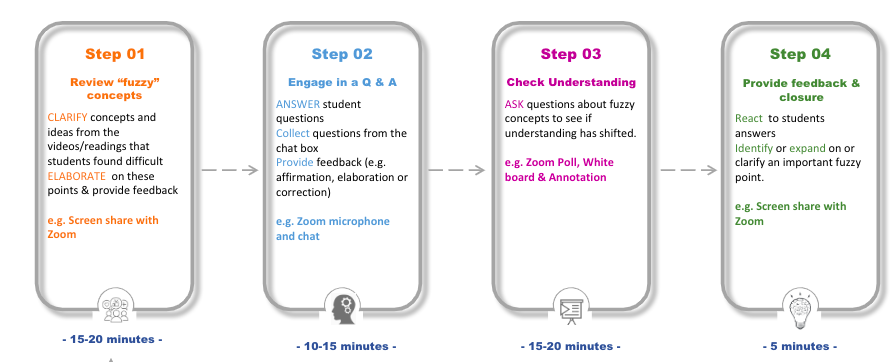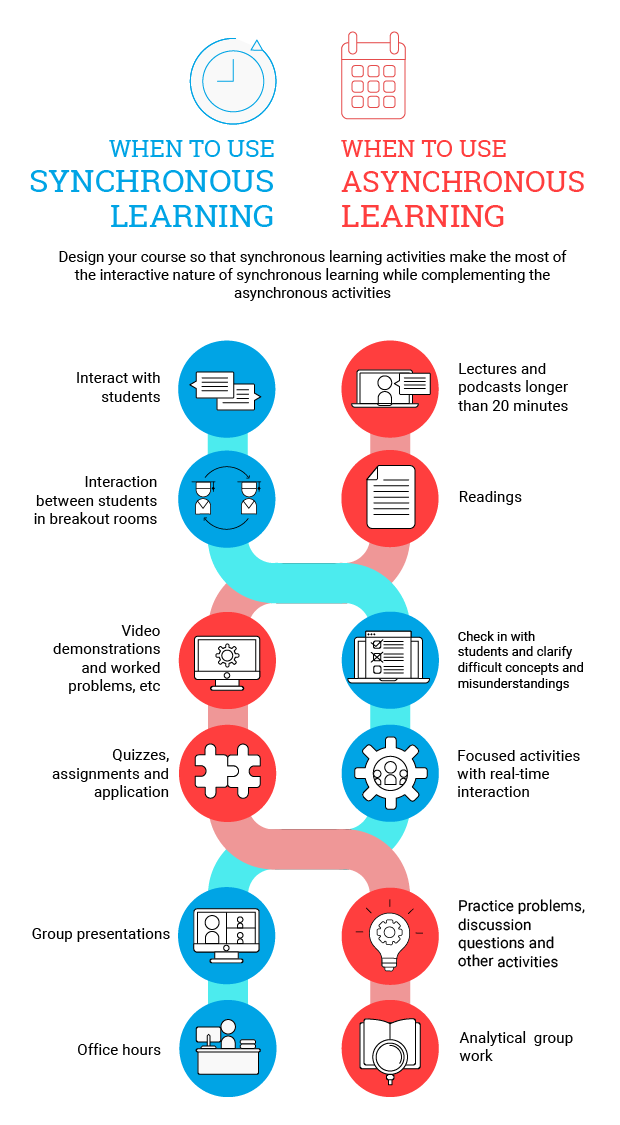Synchronous and asynchronous learning
There are two basic formats of learning in an online environment.
Synchronous learning
Synchronous learning is any activity in an online course that happens in real-time, like a Zoom meeting or a chat. It requires all participants to be in the same online environment, actively participating at the same time. It is typically characterized by opportunities for interaction between the instructor and students and amongst students, such as a Q & A, a Class Discussion or Office Hours.
Advantages |
Disadvantages |
|---|---|
|
Unfortunately, while online learning can improve access for certain individuals, Synchronous learning can widen the divide for learners with:
|
Asynchronous learning
Asynchronous learning is all the other activities in an online course that students can complete on their own schedule. While there may still be due dates, students can generally complete these any time within the given timeline for the task. These activities can include video lectures, readings, assignments and group discussions or collaborative tasks.
Advantages |
Disadvantages |
|---|---|
|
|
When to use each format?
Pre-COVID, the typical online course did not include a synchronous element. Most online courses were designed to be flexible and completed by anyone on their own schedule within the course parameters. However, synchronous sessions can be effective to enhance the course when designed to take advantage of the interactive elements the tool has to offer.
As we move to teaching online, it seems logical to want to take a classroom experience that works well and try and replicate it in the online environment. However, we have to consider that as we change environments, we also need to adapt. Zoom is not the same as a classroom experience - the live online environment does not offer the same engagement as a physical classroom, and there are many more opportunities for distraction online. In addition, there are many barriers in getting students to connect online at the same time in the same place.
This being said, synchronous sessions can be effective to enhance the rest of the course when designed to take advantage of the interactive elements the tool has to offer. A synchronous session is best served by complementing other online activities and increasing teacher and social presence through interaction.
Considering the access disadvantages of synchronous learning and the many advantages to asynchronous learning, the best use of synchronous meetings like Zoom sessions are when instructors are making the most of what synchronous learning can do in a course.
This means taking advantage of the opportunities for interaction, feedback and social engagement.
When to use it:
To provide opportunities for you as the instructor to interact with your students, for example a question and answer period
To check in with students and collect feedback on their learning (for example, using polls to check understanding)
For activities where students interact with each other (for example, in break out rooms) on a specific, focused task that requires real-time interaction
For Group presentations (consider splitting Zoom session to have 3-4 groups at a time)
For Office Hours
When not to use it:
To lecture for a duration over 20 minutes
To do worked problems (i.e. walking through the steps of solving a problem) and demonstrations
For class discussions and group work that do not require real-time interaction, and which might require careful consideration, analysis, constructive exchange, etc.
If you do plan to run synchronous sessions, make sure to have a clear goal and create a detailed plan for each minute of the session that takes advantage of the time you have with your students and makes the most of the time the students have with you.
How long should a synchronous session be?
Keeping in mind that a Zoom classroom is not the same as a face-to-face classroom because of the connectivity challenges and the nature of online environments, it is not recommended to hold 2 hour, forty-five minute sessions in Zoom. The ideal length of a Zoom session should be 45-60 minutes.
Choosing the right mode and technology for your teaching
While there is no single ‘right’ way to teach online, the following table may offer some helpful guidance in choosing the most appropriate mode and technology. It lists typical academic activities and identifies effective use cases, challenges and potential workarounds in each mode.
Academic Activities |
Synchronous (Zoom) |
Asynchronous (Moodle and other tools) |
|---|---|---|
Lectures |
CHALLENGES
|
CHALLENGES
|
Videos |
CHALLENGES
|
CHALLENGES
|
Case Studies |
CHALLENGES
|
CHALLENGES
Suggested Technology: Moodle Discussion Forum using "Separate groups" and/or a collborative document (such as Moodle wiki or Google Docs) to document analysis. |
Experiential / Labs |
CHALLENGES
|
CHALLENGES
|
Performance / Creation |
CHALLENGES
|
CHALLENGES
|
Tutorials |
CHALLENGES
|
CHALLENGES
|
Collaborative Work |
CHALLENGES
|
CHALLENGES
Suggested Techonology: Moodle Discussion forum using "Separate groups" and/or a collaborative document (i.e. Google Docs) to document analysis
|
Group Discussions |
CHALLENGES
|
CHALLENGES
Suggested Techonology: Moodle Discussion forum using "Separate groups"
|
Presentations |
CHALLENGES
|
CHALLENGES
|
Research Assignments |
CHALLENGES
|
CHALLENGES
|
Assessment |
CHALLENGES
|
CHALLENGES
|
Adapting your course
If you are not sure how to adapt your course, please find a couple of models below to help you plan your own course.
If your typical face-to-face lecture time was structured as...
...your online course might look like this:
Online Week
- Four to six video mini lectures (7-20 min. each)
- Selected readings on the topic
- A 5 -10 question quiz to test general understanding of concepts presented in the videos.
- A 50 minute Zoom session
- One to three Practice Activities (Discussion Forum or other type of practice in group or individually)
- Individual Application Activity (optional depending on weekly workload and content)
Zoom Session Format

...your online course might look like this:
Online Week
- Two to Four video mini lectures (7-20 min. each)
- Selected readings on the topic.
- Discussion Forum (Reading/Video summary, reaction or analysis)
- A one-hour Zoom session
- Collaborative Group Activity (Discussion Forum or Collaborative Task)
- Reflection or Application Activity (optional depending on weekly workload and content)
Zoom Session Format


